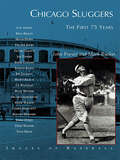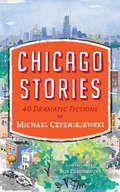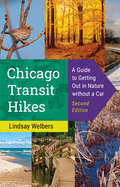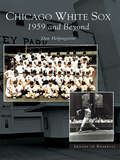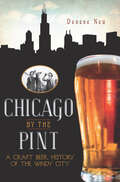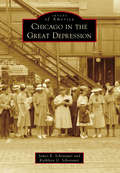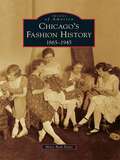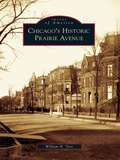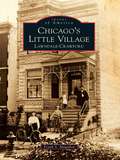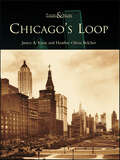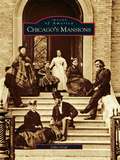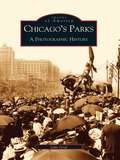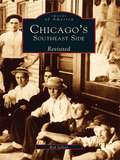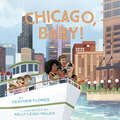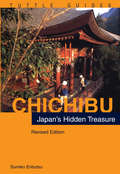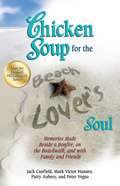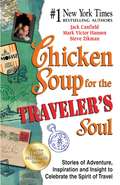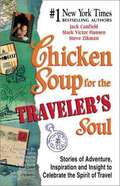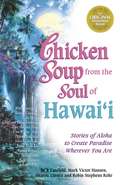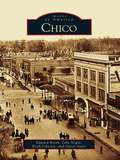- Table View
- List View
Chicago Noir: The Classics (Akashic Noir #0)
by Joe MenoNelson Algren, Richard Wright, and Patricia Highsmith are just three of the iconic authors included in this outstanding volume.“In this superior entry in Akashic’s noir series, Meno offers nearly a century of Chicago crime fiction. . . . Familiar bylines abound: Max Allan Collins, Richard Wright, Nelson Algren, Sherwood Anderson, Fredric Brown, Patricia Highsmith (with an excerpt from her novel The Price of Salt), Stewart M. Kaminsky, Sara Paretsky. Others may be less familiar to mystery specialists, but all turn in impressive performances.” —Publishers Weekly, Starred Review “Richard Wright, Nelson Algren, and Sandra Cisneros are not crime-fiction writers, and yet their Chicago certainly embodies the individual-crushing ethos endemic to noir. Meno also includes stories from writers who could easily have been overlooked (Percy Spurlark Parker, Hugh Holton) to ensure that diverse voices, and neighborhoods, are represented. Add in smart and essential choices from Fredric Brown, Sara Paretsky, and Stuart Kaminsky, and you have not an anthology not for crime-fiction purists, perhaps, but a thought-provoking document all the same.” —BooklistAlthough Los Angeles may be considered the most quintessentially “noir” American city, this volume reveals that pound-for-pound, Chicago has historically been able to stand up to any other metropolis in the noir arena. Classic reprints from: Harry Stephen Keeler, Sherwood Anderson, Max Allan Collins, Richard Wright, Nelson Algren, Fredric Brown, Patricia Highsmith, Barry Gifford, Stuart M. Kaminsky, Libby Fischer Hellmann, Sara Paretsky, Percy Spurlark Parker, Sandra Cisneros, Hugh Holton, and Stuart Dybek. From the introduction by Joe Meno: More corrupt than New York, less glamorous than LA, Chicago has more murders per capita than any other city its size. With its sleek skyscrapers bisecting the fading sky like an unspoken threat, Chicago is the closest metropolis to the mythical city of shadows as first described in the work of Chandler, Hammett, and Cain. Only in Chicago do instituted color lines offer generation after generation of poverty and violence, only in Chicago do the majority of governors do prison time, only in Chicago do the dead actually vote twice. Chicago—more than the metropolis that gave the world Al Capone, the Saint Valentine’s Day Massacre, the death of John Dillinger, the crimes of Leopold and Loeb, the horrors of John Wayne Gacy, the unprecedented institutional corruption of so many recent public officials, more than the birthplace of Raymond Chandler—is a city of darkness. This darkness is not an act of over-imagination. It’s the unadulterated truth. It’s a pointed though necessary reminder of the grave tragedies of the past and the failed possibilities of the present. Fifty years in the future, I hope these stories are read only as fiction, as somewhat distant fantasy. Here’s hoping for some light.
Chicago Sluggers: The First 75 Years (Images of Baseball)
by Mark Rucker John FreyerThe Chicago White Stockings--later renamed the Cubs--won the inaugural National League Pennant in 1876 with a barrage of offensive numbers. Ross Barnes led the league at a .421 clip, and three other Chicago batters finished among the league's top five hitters. Even pitcher Al Spalding hit an impressive .312. Thus began the "northsiders" tradition of producing some of the major leagues' greatest sluggers--including "Cap" Anson, "Gabby" Hartnett, and "Hack" Wilson.The Chicago White Sox--still named the White Sox--won the inaugural American League Pennant in 1901, led by Fielder Jones' .311 average for a team built more around pitching than hitting--a team that won its first World Series title in 1906 with the nickname "The Hitless Wonders." But the "southsiders" also put up some lofty offensive numbers with the likes of Shoeless Joe Jackson and Eddie Collins.
Chicago Stories: 40 Dramatic Fictions
by Rob Funderburk Michael CzyzniejewskiFor everyone who's always wondered what would happen if Roger Ebert had taken Oprah Winfrey to a critics' screening of Revenge of The Nerds for their second date..In Chicago Stories: 40 Dramatic Fictions by Michael Czyzniejewski, each story is told in the persona of a famous Chicagoan, from Mrs. O'Leary to Barack Obama.Illustrated by Chicago artist Rob Funderburk
Chicago Transit Hikes: A Guide to Getting Out in Nature without a Car
by Lindsay WelbersTaking the train to nature in Chicagoland Beyond the steel and asphalt await natural spaces that are easy to access and balm for the soul. Lindsay Welbers’s guide tells readers how to use Chicagoland’s extensive public rail system to reach forests, prairies, wetlands, dunes, and Lake Michigan. Designed to take up minimal space in a backpack, Chicago Transit Hikes provides train-to-trailhead information for thirty nature treks with features that include: Chapters with hikes organized by each rail line on the Metra, the South Shore train, and the CTA; Information on everything from accessibility to dog-friendliness to flora and fauna; Detailed descriptions of every destination; Practical tips on packing lists and itineraries. Up-to-date and user-friendly, Chicago Transit Hikes connects Chicagoans and visitors alike with excursions for every season and level of difficulty.
Chicago White Sox: 1959 and Beyond (Images of Baseball)
by Dan HelpingstineThe Chicago White Sox are a charter member of the American League. Through a little over a century of baseball, they have accumulated a history of triumphs, scandals, and heartbreaking setbacks. The photographs in this book come from the collections of Leo Labau, Mark Fletcher, and Gerry Bilek, three lifelong White Sox fans. The images show dramatic, emotional, and light moments that could only happen in a baseball game played on the south side of Chicago. In these pages you will find showmen Bill Veeck and Harry Carey, the 1959 World Series, sluggers like Allen, Melton, Zisk, Gamble, and Kittle, and great pitchers like Peters, Horlen, and Wood. There are no world championships in this story, just the great moments of a team that hasgiven its fans great memories.
Chicago by the Pint: A Craft Beer History of the Windy City (American Palate Ser.)
by Denese NeuPerfect for &“beer nerds and history buffs . . . This quirky volume . . . uses Chicago-area breweries as an entry point into the city s broader history&” (Time Out New York). Chicago is full of colorful history, local legends, and great beer—and they all converge in this pint-sized history of brewing and drinking in the Windy City. Author Denese Neu uses the local craft brewing industry as a gateway to Chicago&’s storied past, with tales designed to be read in the time it takes to enjoy a pint or two. So belly up to the bar and learn how Chicago&’s best brews were born, and how some of its historic breweries and brewpubs are connected to notable figures from sports legends to bank robbers and more.
Chicago in the Great Depression
by James R. Schonauer Kathleen G. SchonauerCarl Sandburg called Chicago the "City of the Big Shoulders," and those shoulders withstood the stock market crash of 1929. Chicagoans rallied to collect funds to celebrate the centennial of the city's incorporation in 1833. A Century of Progress International Exposition, held in 1933 and 1934, brought jobs and businesses to Chicago and cheered people with the prospect of new technology and the promising face of the future. Neighborhood churches and community organizations helped each other, and the Great Migration brought new arrivals from the American South. Together, these factors helped to hasten the end of Prohibition and the fall of notorious gangsters like Al Capone and John Dillinger. Jazz rolled in, with Chicagoans dancing along to the tunes of the big bands. Even if pocketbooks were bare, souls were full of hope.
Chicago's Fashion History: 1865 - 1945
by Mary Beth KlattFrom the ashes of the Chicago Fire of 1871 came the birth of the city's fashion scene as entrepreneurs built new storefronts virtually overnight. Aided by the Windy City's incredible network of railroads, these fledgling enterprises in turn created millionaires who wanted to wear the latest clothes from Europe. Marshall Fields and Potter Palmer were among the local elites who regularly boarded ships to France and returned with exquisite suits, coats, hats, gowns, fabrics, and other accessories, which designers sought to re-create with cheaper fabrics and labor. Chicago's reputation as a trendsetting metropolis was only sealed by the city's film industry. Charlie Chaplin and his cast of stylish starlets had women north and south of Madison Street copying every hairdo and dress. Even after moviemaking moved to Los Angeles, actors and actresses traveling to New York City regularly dropped in when they switched trains downtown. By World War II, Chicago, the "City of Big Shoulders," became the place to start a career as a fashion designer.
Chicago's Grand Hotels: The Palmer House Hilton, The Drake, and The Hilton Chicago
by Robert V. AllegriniArchitecturally imposing, historically rich, and socially important, Chicago's magnificent grand hotels have fascinated generations of Chicagoans and have pleased generations of guests. The Palmer House Hilton, The Drake, and The Hilton Chicago have come to represent a collective formal living room for Chicago, where the city's most important visitors are accommodated, entertained, and made aware of the grandeur and sophistication of their host's hometown. They were built to inspire awe--and still do for anyone fortunate enough to find themselves in the lobby of The Palmer House Hilton, The Palm Court of The Drake, or the Grand Ballroom of The Hilton Chicago.Many of the most famous locales in these classic structures have been transformed or have disappeared altogether due to changing times. Gone, for example, is The Hilton Chicago's famous rooftop miniature golf course and Boulevard Room supper club, complete with its ice shows. Gone, too, is The Drake's legendary supper club, the Camellia House. While the Empire Room of The Palmer House Hilton continues to exist as an function room, it no longer reverberates with the sound of Liberace's piano or Jimmy Durante's vocals, as it did when it was the city's premier entertainment facility. Chicago's Grand Hotels chronicles over 100 years of Chicago hotel history through vivid photographs and memorabilia from the archives of The Palmer House Hilton, The Drake, and The Hilton Chicago. It tells the compelling story of the visionary architects and hoteliers who brought these hotels to life and made them structural testaments to the warmth of midwestern hospitality.
Chicago's Historic Prairie Avenue (Images of America)
by William H. TyrePrairie Avenue evolved into Chicago's most exclusive residential street during the last three decades of the 19th century. The city's wealthiest citizens--Marshall Field, Philip Armour, and George Pullman--were soon joined by dozens of Chicago's business, social, and civic leaders, establishing a neighborhood that the Chicago Herald proclaimed "a cluster of millionaires not to be matched for numbers anywhere else in the country." Substantial homes were designed by the leading architects of the day, including William Le Baron Jenney, Burnham and Root, Solon S. Beman, and Richard Morris Hunt. By the early 1900s, however, the neighborhood began a noticeable transformation as many homes were converted to rooming houses and offices, while others were razed for construction of large plants for the printing and publishing industry. The rescue of the landmark Glessner house in 1966 brought renewed attention to the area, and in 1979, the Prairie Avenue Historic District was designated. The late 1990s saw the rebirth of the area as a highly desirable residential neighborhood known as the South Loop.
Chicago's Little Village: Lawndale-Crawford
by Frank S. MagallonLittle Village has been known by several names over the past 140 years, but its rich culture and history have never been forgotten. Situated on Chicago's southwest side, Little Village has gone from real estate promoters Millard and Decker's affluent "suburb" Lawndale to one of the largest Bohemian enclaves in the United States. This vibrant neighborhood is known today as the largest Mexican community in the state of Illinois. Little Village has almost always been a working-class immigrant neighborhood filled with hardworking men and women who want their piece of the American dream. From residents such as martyred Chicago mayor Anton Cermak to the typical immigrant family next door, these strong-willed people have made their mark on Chicago and the rest of the world.
Chicago's Loop (Then and Now)
by Heather Olivia Belcher Janice A. KnoxFrom 19th century trading post to one of the world's great financial, business, and entertainment districts, experience the growth and changes of the Windy City.Chicago's famed Loop is said to have gotten its name from the route of a cable car that looped the central business district in 1882. Since then, much has changed.This book captures the evolving urban landscape of the Chicago Loop, with a collection of over 100 vintage images, each coupled with its contemporary counterpart. Few cities are as renowned for their architecture as is Chicago. The impressive skyscrapers in and around the Loop give Chicago a skyline second to none. And with more than three dozen historic landmarks, the Loop is home to many of the city's most recognized structures.Authors Janice A. Knox and Heather Olivia Belcher are both native Chicagoans and collectors of Chicago memorabilia. Together they have created a book that shows us the Chicago we know and love today, along with a clear echo of the city's rich, ever-changing landscape.
Chicago's Mansions
by John GrafChicago is known throughout the world for its architecture. Although many people are familiar with the city's skyscrapers and public buildings, they often overlook or are unaware of Chicago's mansions that are located throughout the city. These mansions represent Chicago's past and its future, and it can even be said that they are the very embodiment of Chicago and its architecture. These fashionable residences were built to make a statement, and what better way to have done this than to employ the leading architects of the time to design them. These architects included men such as Louis Sullivan, Frank Lloyd Wright, Henry Hobson Richardson, Daniel Burnham, and John Wellborn Root. While the city's mansions are significant because of who built them, they are just as important because of who lived in them. Many of these mansions were built for Chicago's elite businessmen and captains of industry-men who represented old money, new money and big money. Just as important were the families of these men and the other residents who came to live in these mansions-for they left a legacy of their own that contributed to the city's history.
Chicago's Parks: A Photographic History
by John GrafNo other city in the world has a park system as great as Chicago's, which includes over 550 parks totaling more than 7,000 acres. Each park has its own story, as well as unique characteristics and history, and yet the majority of Chicagoans are not aware of the wealth, variety, and sheer number of parks that exist, to say nothing of the ideas theyproject, the history they commemorate, and the origins of their names. Chicago's Parks: A Photographic History seeks to remedy this oversight. From Chicago's first park, Dearborn Park, to its more famous parks of Grant and Lincoln, this book provides a wealth of information concerning the origins of the names and plans of these Chicago landmarks. A formal plan for the creation of a park system was developed in 1869, and soon Chicago had some of the greatest parks to be found anywhere in the world. When Chicago was founded in 1837, the city's fathers adopted the motto urbs in horto, or "the city set in a garden." Despite the numerous changes that have taken place over the past 160 years, Chicago is still a city set in a garden. Chicago's Parks: A Photographic History captures the growth of that "garden" with its nearly 200 historic photographs.
Chicago's Southeast Side Revisited
by Rod SellersOne of the phrases that has been used to describe Chicago's Southeast Side is "smokestacks and steeples." The community initially developed because of the steel industry, but it has been affected by the decline of the American steel industry in recent years. Today, the people of South Chicago, South Deering, the East Side, and Hegewisch look to the future. The community is, in many respects, at a crossroads. Will economic redevelopment occur, and if it does, at what price? Will the ecology and environment, damaged by years of abuse and neglect, be restored and protected?This second book about the region tells the story of this interesting and vibrant Chicago community from a chronological approach. It looks at important themes of American history from the perspective of this urban, working-class community. Industrialization, urbanization, unionization, immigration, and Americanization were themes that played out on the Southeast Side of Chicago. It examines how the community dealt with problems like depression, wars, pollution, and the decline of heavy industry-especially the steel industry.
Chicago, Baby!
by Feather FloresExploring Chicago has never been so fun! Embrace adventure with this memorable rhyming picture book, the perfect gift for residents and visitors alike!Hello, Chicago, and hooray!Adventure waits for us today!From the shores of North Avenue Beach to the iconic CLOUD GATE (the Bean), there's so much to do and see in the bustling city of Chicago! With stops at the Art Institute, Grant Park, Navy Pier, and more, this spirited tour of the Windy City is just right for little readers—and their parents!—who are eager to explore. Get ready for adventure—an unforgettable Chicago experience awaits!A REGIONAL CELEBRATION FOR RESIDENTS: Featuring some of Chicago's most popular foods, well-known destinations, and family-friendly attractions, this book makes a great gift for (or from!) any Chicagoan looking to pass on a love of their city to their little ones.MEMORIES FOR LITTLE TRAVELERS: With so much to see and do, travel can feel overwhelming for toddlers—but telling the story of a place you've been (or are planning to visit) can make the experience so much more fun and accessible!SWEET AND SATISFYING READ-ALOUD: Rhyming text and short, easy-to-understand sentences make this upbeat picture book an excellent candidate for story time, just right for rereading—and for reliving the adventures little explorers and their families have enjoyed together in the city!GO-TO GIFT FOR TODDLERS ON THE GO: This lighthearted introduction to the Windy City is a gift-giver's dream, offering a wonderful way to share meaningful adventures with the little readers they love.Perfect for:• Parents, grandparents, and caregivers of children who live in Chicago• Museum-goers and travelers to the Chicago area• Teachers and librarians who live in Chicago• Gift-givers looking for a fun and quirky regionally inspired present
Chicas en New York: Los secretos mejor guardados de la Gran Manzana
by Andy ClarLa guía más completa de la ciudad que nunca duerme.New York es una ciudad que cautiva, enamora y esconde rincones que pocos conocen. ¿Dónde comprar un vestido de novia? ¿Cómo se consiguen prendas en liquidación de los más reconocidos diseñadores? ¿A qué restaurantes van a cenar las estrellas de cine? ¿Cuáles son las mejores terrazas para tomar un trago? ¿Qué actividades hacer sin gastar un solo dólar? ¿Adónde ir a pasear en familia?#ChicasenNY es una guía para mujeres prácticas, curiosas y sensibles que no se conforman con los consejos tradicionales acerca de la ciudad y van por más. Para chicas que buscan experiencias que puedan recordar durante toda su vida.#AndyClar, creadora de la comunidad "Chicas en NY", propone una forma distinta de vivir la Gran Manzana, ya sea desde los tacos de una mujer moderna, los ojos de una artista, la organización de una madre o la creatividad de una publicista.Con la colaboración de Jessica Lekerman, Julieta Pink, Laura Azcurra, Malena Guinzburg, Dalia Gutmann, Mona Gallosi y Flor Torrente, entre otras, Andy revela tips, anécdotas e historias personales como lo haría una amiga cuando vuelve de viaje. Este libro es para mujeres de todas las edades y ámbitos que quieran conocer New York como nunca lo imaginaron.
Chichibu
by Sumiko EnbutsuRevised and updated by the author, this is the only guide to one of Japan's best-kept secrets, an idyllic haven of temples, shrines, and serene hills only a short train ride from the heart of Tokyo. Chichibu, a quiet basin enclosed by steep hills, is an area that evokes the charm and beauty . of traditional Japan. This book features newly updated, easy-to-follow maps of the 34-temple pilgrimage route and a foldout map of the Chichibu area; model itineraries; and comprehensive information about the area's numerous festivals. Copyright © Libri GmbH. All rights reserved.
Chicken Soup for the Beach Lover's Soul: Memories Made Beside a Bonfire, on the Boardwalk, and with Family and Friends
by Jack Canfield Mark Victor Hansen Patty Aubery Peter VegsoOpen your heart to the magic found at the water's edge . . . There are many places we can go to enjoy time with friends, to have an action-packed vacation, or to enjoy a little solitude, but none of them have the same ability to soothe our souls as the beach. Perhaps it's the magic portrayed by children building sand castles or the gentle sounds of lapping waves on the shore. Chicken Soup for the Beach Lover's Soul is filled with recollections of special moments that will be appreciated by anyone who has been mesmerized by the spell of the ocean. Color photos of magnificent beach destinations across the United States, from the quaint, historic surroundings of Cape May, New Jersey, to the sultry scenes of Big Sur, California, capture the magic of America--from sea to shining sea. This unique compilation conjures up memories of family beach outings, the joy of finding a spectacular seashell, young love discovered on the sand, and mature love rekindled at the seashore. Join us on this journey of beaches far and near and remember the fun and excitement you found there, and be inspired to create new memories.
Chicken Soup for the Canadian Soul
by Jack Canfield Mark Victor Hansen Raymond Aaron Janet MatthewsWearing poppies on your lapel during the month of November. Enjoying local fiddlers playing music on Cape Breton Island. Cheering your favorite team on during Hockey Night. Swatting mosquitoes in Muskoka on the first long weekend in May. Driving the Trans-Canada Highway. Questioning why the ABC song ends in "z" and not "zed." All these things are distinctly Canadian and now there's another one more: Chicken Soup for the Canadian Soul. Written by fellow Canadians from Cape Breton Island to Prince Edward Island, from Montreal to Vancouver, this book reveals the people, the history and the special moments that give Canada such a distinctive charm and character. With chapters including: On Being Canadian, Living Your Dream, Overcoming Obstacles, On Love, On Kindness, and Making a Difference, these stories weave a rich tapestry of life from the people who call Canada home. Notable stories include: hockey player Paul Henderson's "Goal of the Century," Chief Dan George's recounting of his great land, Marilyn Bell DiLascio's historic 1954 Lake Ontario swim, cartoonist Lynn Johnston's delightful story of an encounter with Wayne Gretzky, and journalist Sally Armstrong's details of Princess Diana's first trip to Canada. Like hearing a heartfelt version of "O, Canada!" this book will instill renewed pride and patriotism in a well-deserving country and its people.
Chicken Soup for the Traveler's Soul
by Jack Canfield Mark Victor Hansen Steve ZikmanWhether your idea of travel at its finest is trekking through Europe with a backpack, a map and a foreign-language dictionary; road-tripping across America in a fully loaded RV; or cruising the Caribbean aboard a luxury liner, Chicken Soup for the Traveler's Soul celebrates the people you'll meet, the lands you'll discover and the lessons you'll learn. Like traveling itself, the stories in this book will take you on a journey of adventure, insight, and discovery. Through the real-life experiences of others, you'll see that regardless of the destination, it is the journey that provides the fondest memories. You'll be inspired by these treasured tales of fellow travelers who formed lasting friendships, fell in love, challenged themselves, and cherished the hospitality of others. These stories show that when traveling--as in life--sometimes it's the unplanned adventures that provide us with the most opportunities for growth; that a twist in the road or a change in our itinerary teaches us not to fear the unknown, but to welcome and savor its surprises. With chapters including Living Your Dream, Getting There, Our Common Bond, Making a Difference, On Healing, On Love, A Matter of Perspective, The Kindness of Strangers, and Wisdom Along the Way, this book will guide you to where you want to go and celebrate the places you've already been. Chicken Soup for the Traveler's Soul will rekindle the spirit of every traveler, offer a deeper connection to people across the globe and provide you with a richer appreciation of the journey.
Chicken Soup for the Traveler's Soul: Stories of Adventure, Inspiration and Insight to Celebrate the Spirit of Travel
by Mark Victor Hansen Steve Zikman Jack L. CanfieldWhether your idea of travel at its finest, is trekking through Europe with a backpack, road-tripping across America in a fully loaded RV, Chicken Soup for the Traveler's Soul celebrates the people you'll meet and the lessons you'll learn.
Chicken Soup for the Traveler's Soul: Stories of Adventure, Inspiration and Insight to Celebrate the Spirit of Travel
by Jack Canfield Mark Victor Hansen Steve ZikmanWhether your idea of travel at its finest is trekking through Europe with a backpack, a map and a foreign-language dictionary; road-tripping across America in a fully loaded RV; or cruising the Caribbean aboard a luxury liner, Chicken Soup for the Traveler's Soul celebrates the people you'll meet, the lands you'll discover and the lessons you'll learn. Like traveling itself, the stories in this book will take you on a journey of adventure, insight, and discovery. Through the real-life experiences of others, you'll see that regardless of the destination, it is the journey that provides the fondest memories. You'll be inspired by these treasured tales of fellow travelers who formed lasting friendships, fell in love, challenged themselves, and cherished the hospitality of others. These stories show that when traveling--as in life--sometimes it's the unplanned adventures that provide us with the most opportunities for growth; that a twist in the road or a change in our itinerary teaches us not to fear the unknown, but to welcome and savor its surprises. With chapters including Living Your Dream, Getting There, Our Common Bond, Making a Difference, On Healing, On Love, A Matter of Perspective, The Kindness of Strangers, and Wisdom Along the Way, this book will guide you to where you want to go and celebrate the places you've already been. Chicken Soup for the Traveler's Soul will rekindle the spirit of every traveler, offer a deeper connection to people across the globe and provide you with a richer appreciation of the journey.
Chicken Soup from the Soul of Hawai'i
by Jack Canfield Mark Victor Hansen Sharon Linnea Robin Stephens RohrAll over the world people have a word for paradise: Hawai'i. Now there's a book that captures that magical place for its millions of residents, the 7 million visitors who make a pilgrimage there each year, and the millions more who long to feel the magic of Hawai'i on cold winter mornings. While the Hawaiian landscape is unparalleled--sun-drenched beaches, wild waves, snow-capped peaks, cascading waterfalls, and dramatic volcanoes--the true spirit of Hawai'i lives in its people and their experiences. Now, the people of Hawai'i and those who love it share its special magic in this beautiful collection of stories. From celebrities including Bo Derek, Clint and Dina Eastwood, Don Ho, Regis and Joy Philbin, and Kelly Preston, to native storyteller Nalani Olds, activist and teacher Kanalu Young, and world-class surfers, athletes, hula masters, and master chefs, this book brings the gifts of Hawai'i to the world. Whether readers remember Hawai'i as the place where they fell in love or celebrated their honeymoon, the place they yearn to visit or the place they call home, this book exudes the aloha spirit with every turn of a page.
Chico
by Keith Johnson Darcy Davis John Nopel Edward BoothOver time, the land of the Mechoopda Indians, where elk herds grazed on blue-stemmed grass, became Rancho Arroyo Chico, the land chosen by California pioneer John Bidwell for his stately creekside mansion. Bidwell later founded the town of Chico with its wooden plank sidewalksand iron-front and brick commercial buildings. Today Chico is a dynamic modern city with its own California State University, a wide, tree-lined Esplanade, and--thanks to the legacy of Annie Bidwell--the eighth-largest municipal park in the nation.

